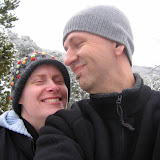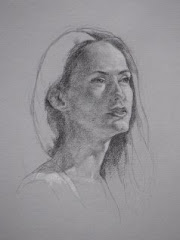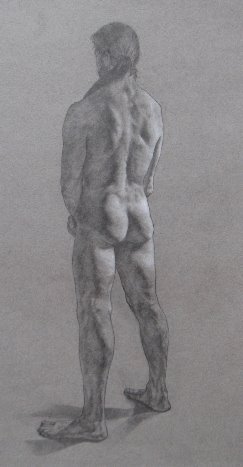
A few weeks ago I met a young man from San Felipe Pueblo
Ray Lucero makes custom-made moccasins in the traditional method.
He traced my left foot, ("your left foot is always the biggest"),
and about a week later I was enjoying my fawn-colored low-cut moccasins.
Ray is self-taught;
"I watched other make them over the years and figured I could try".
And I quickly decided to become one of his dedicated customers
after looking over a wide array of turquoise, dark blue, black, white, and wine-red samples
at a craft show held at my hospital.
I purchased a low-cut fawn-tone pair. I wear about an 8-1/2; so the moccasins were $85.

He makes infant, toddler, children and adult-sized moccasins; both low-cut and high-top.
He specializes in high-top white moccasins for the Pueblo/Native dancers.
This past week, I met his sisters.
They were quick to ask if I liked my moccasins
(Yes! Very much!)

asked if I would be wearing them to work at the hospital
(Heavens NO! Too much wet and slimy, scary stuff on the floors!)
and to give me information for a local shoe repair shop;
to have my leather-soled moccasins protected with rubber soles.
I'll probably pass:
I can appreciate protecting the shoes to last longer, and being able to wear them outdoors.
But I'd like to think I am more traditional in my style sense.
These moccasins will stay inside; on our warm rug, padding across our stone or tile floors,
or simply resting on the leather footstool near my reading chair.
Ray Lucero lives in San Felipe Pueblo; between Albuquerque and Santa Fe.
San Felipe Pueblo a traditional Pueblo;
and many who live there are working to bring back their language, "Keresan",
a lilting, soft, breathy language that is a joy to listen to.
I listened to his sisters and his mother talk and laugh for a good 30 minutes,
hearing words like "therapist", medicine", and "Albuquerque"
sprinkled through the conversation, and not understanding anything else.
One sister told me about volunteering at a language school the Pueblo has recently started.
Ray doesn't have email or a website. He doesn't own a computer.
He doesn't drive much; (his mom says, "that old truck doesn't run too well"),
and he doesn't handle credit cards.
He will take cash once the moccasins are done,
(he doesn't have a bank account; so it may take a little time to have a check cashed),
but he is a sweet young man with a quick, shy smile.
And wonderful hand-made moccasins.
Traditional Moccasin
Ray Lucero
PO Box 4062
San Felipe Pueblo, NM 87001
(505) 274-5565
Please tell Ray that "Marty from Kindred Hospital in Albuquerque" told you about him.
















5 comments:
Marty,
What are the soles on your mocassins made of? A heavier hide like elk? It doesn't look to be rubberized. I had a pair of mocassins years ago I ordered through Mother Earth News. Elk hide and I forget what the soles were made of. Believe it was some sort of rubber. Most comfortable pair of shoes that lasted a great number of years. Prepared in the same way, I had to trace my feet and send them off to somewhere out in Washington state. Don't remember the manufacturer and don't see anything in Mother Earth News that looks like them. Will keep Ray in mind should I purchase some more again though Kath uses the same technique and has made me a pair of mocs. Had them for a number of years now. Don't wear them outside too much. Have for playing at reenactments from time-to-time but play a very few now-a-days.
Greetings to John.
Best,
Joe
To Joe (And anyone else - wondering)
The soles are a thick leather (maybe elk?) called "latigo leather" which when cured is a cramy white color. The soles are slightly more than 1/2" thick and my moccasins are slowly forming to conform to my feet as I wear them. I'll be visiting Ray (the maker) and his family on Christmas Day at the pueblo, and hope to get his permission to complete a blog story about his work.
They are called Kaibab or Navajo moccasins and sometimes Ute boots. They are traditional moccasins worn by the native tribes of the southwest. Pop "kaibab moccasins" in a your favorite image search engine and you'll find the styles
What makes these moccasins unique is how they're made. All the stitching used to attach the uppers to the thick latigo leather sole is done by hand on the inside of the moccasin. Because of the unique stitching all true Kaibabs are hand crafted; no machine can duplicate the stitch. These moccasins are made to survive everyday wear in the rough desert conditions of the southwest United States. The soles are thick to protect the foot from rocks and thorns. The uppers are made of a single piece of leather wrapping the foot and ankle (at least the boots are) to provide protection and maybe just a bit of support. The "invisible" stitching is done to protect it from abrasions and cuts; the moccasin stays together. Overall you get a very rugged, lightweight moccasin.
Kaibabs, like most true moccasins, just get better with age. The bright white soles acquire a nice patina, soften and shape to your foot. Wear them often ...and don't be afraid to wear them outside ...they can take the concrete trails of urban life just as easily as a hike in the desert. The only thing to avoid would be wet weather.
I think they have a cool look and are great with jeans. I have a pair of single-button ankle boots; they are one of my favorite pair of moccasins. I succumbed to comfort and added real sheepskin insoles to my pair; not only does it soften your step they also keep your feet warmer for wear in cooler climes.
This is so interesting--would love to find out more! Tried calling his number but it leads nowhere... any other ways to get hold of him?
To Anonymous (which makes it tough to contact you directly) I will see if I can locate his number. And I will post and updated blog if I find a new number...
Post a Comment